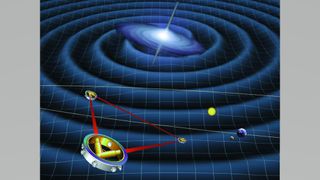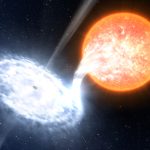Key Takeaways:
- Black hole mergers can result in a powerful “kick,” ejecting a black hole from its galaxy at staggering speeds, as demonstrated by recent gravitational-wave data analysis.
- Variations in black hole masses or spins during mergers lead to asymmetrical emission of gravitational waves, causing significant recoils in the resultant black hole.
- The detection of such powerful kicks sheds light on binary black hole formation scenarios, impacting our understanding of galaxy evolution, particularly regarding supermassive black holes.
- Advancements in gravitational wave detection technology have enabled the identification of these high-velocity black hole ejections, which would otherwise remain undetectable due to the absence of light emission.
- Insights gained from these findings not only deepen our understanding of astrophysical phenomena but also hold implications for future space-based gravitational wave observatories like the proposed Laser Interferometer Space Antenna (LISA) mission.
Astronomers have revealed compelling evidence suggesting that the collision of black holes can result in a forceful “kick,” propelling one of them out of its galaxy.
The investigation, led by physicist Vijay Varma from the Max Planck Institute for Gravitational Physics, Albert Einstein Institute in Germany, scrutinized data from gravitational-wave detection, particularly the GW200129 event recorded by the LIGO detectors alongside their European counterpart, Virgo. Through meticulous analysis, the researchers found that the resultant black hole from this collision was propelled through space at an astonishing speed of 3 million mph (4.8 million kph) — a revelation described by one team member as “unexpected and astounding.”
“When two black holes merge, they form a more massive black hole. This process can induce a recoil ‘kick’ to the resulting black hole,” explained Varma, the lead author of the study detailing the team’s findings, in an interview with Space.com.
The emission of gravitational waves, akin to gravitational radiation, occurs as black holes orbit each other. These waves carry away energy and angular momentum, causing the orbit to diminish until a collision and merger between the black holes occur.
However, if the black holes possess differing masses or spins, an asymmetry in gravitational wave emission arises, predominantly in one direction. Following the law of conservation of momentum, this asymmetry leads to a significant kick, propelling the resultant black hole in the opposite direction.
“Similar to astrophysical processes emitting electromagnetic radiation, black hole mergers also emit gravitational radiation,” Varma added.
These substantial kicks are anticipated when the orbital plane of the merger undergoes precession or “wobbling.” This precession is observable as a minor modification in the gravitational-wave signal. “This binary black hole system is the first signal indicating substantial signs of orbital precession, where the orbital plane wobbles,” stated co-author Scott Field, a mathematician from the University of Massachusetts Dartmouth, to Space.com.
Varma highlighted that by analyzing gravitational radiation, astronomers and astrophysicists can gain insights into black hole mergers. Moreover, as black holes play a crucial role in galaxy evolution, understanding these processes could elucidate the formation of star collections like the Milky Way.
This marks the first instance where astronomers have amassed compelling evidence demonstrating that such a merger can expel the resultant black hole from its galaxy.
“Unlike previous observations of black hole mergers, this is the first instance providing substantial evidence for a massive recoil velocity. Remarkably substantial, in fact, for the resultant black hole to potentially escape its host environment,” Field remarked. “While we knew in theory that general relativity permitted such extreme possibilities, it was uncertain whether the universe would manifest them. The final black hole’s velocity is likely to surpass the escape velocity of its host environment.”
Field added that this discovery will significantly impact scenarios of binary black hole formation. This is because supermassive black holes, such as Sagittarius A* (Sgr A*) at the Milky Way’s core, form through a sequence of collisions termed hierarchical mergers. Black holes expelled from galaxies cannot partake in this process.
Mergers that give black holes the boot
The ability to detect mergers capable of propelling black holes with significant force has become feasible due to advancements in technology enabling more precise gravitational wave detections.
“Black hole mergers do not emit any light, making gravitational waves the sole means of observation and study. Without gravitational wave observatories, we would remain unaware of this expelled, solitary black hole,” Field emphasized.
Scientists cannot precisely pinpoint the origin of the gravitational wave event GW200129. Consequently, the team cannot definitively ascertain whether the black hole was expelled from its galaxy. However, given its extreme velocity, researchers speculate that this is the likely outcome.
“If indeed the case, it is now drifting through the universe independently as a rogue black hole,” Varma stated.

Varma noted that the merger observed could be a scaled-down version of a more dramatic event. “A similar occurrence transpires when supermassive black holes merge, a phenomenon that can occur following a galactic merger,” Varma explained. “The resultant supermassive black hole may shift from the merged galaxy’s center or even be ejected from it, leaving behind a galaxy devoid of a central black hole.”
While current gravitational-wave detectors lack the capability to observe mergers involving supermassive black holes, the authors suggested that future space-based detectors like the proposed Laser Interferometer Space Antenna (LISA) mission might facilitate such observations.
“Gravitational-wave astronomy has yielded numerous impactful and truly remarkable discoveries in the past five years or so,” Field expressed. “Before the initial gravitational wave detection, the prevailing belief in our field was that gravitational waves would unveil a new perspective on the universe. With each successive LIGO observation, this belief has been vindicated.”
The research findings are detailed in a paper published on May 12 in the journal Physical Review Letters.


